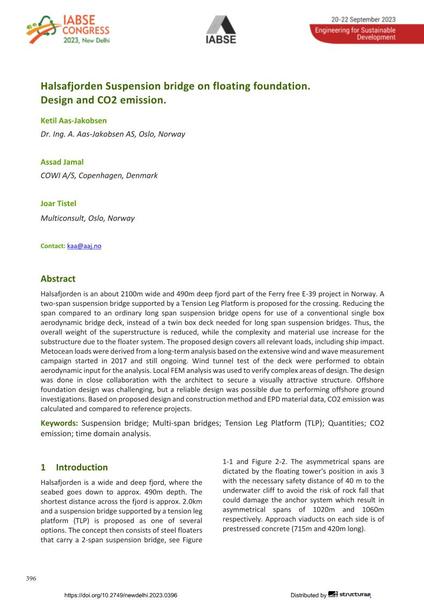Halsafjorden Suspension bridge on floating foundation. Design and CO2 emission.

|
|
|||||||||||
Détails bibliographiques
| Auteur(s): |
Ketil Aas-Jakobsen
(Dr. Ing. A. Aas-Jakobsen AS, Oslo, Norway)
Assad Jamal (COWI A/S, Copenhagen, Denmark) Joar Tistel (Multiconsult, Oslo, Norway) |
||||
|---|---|---|---|---|---|
| Médium: | papier de conférence | ||||
| Langue(s): | anglais | ||||
| Conférence: | IABSE Congress: Engineering for Sustainable Development, New Delhi, India, 20-22 September 2023 | ||||
| Publié dans: | IABSE Congress New Delhi 2023 | ||||
|
|||||
| Page(s): | 396-403 | ||||
| Nombre total de pages (du PDF): | 8 | ||||
| DOI: | 10.2749/newdelhi.2023.0396 | ||||
| Abstrait: |
Halsafjorden is an about 2100m wide and 490m deep fjord part of the Ferry free E-39 project in Norway. A two-span suspension bridge supported by a Tension Leg Platform is proposed for the crossing. Reducing the span compared to an ordinary long span suspension bridge opens for use of a conventional single box aerodynamic bridge deck, instead of a twin box deck needed for long span suspension bridges. Thus, the overall weight of the superstructure is reduced, while the complexity and material use increase for the substructure due to the floater system. The proposed design covers all relevant loads, including ship impact. Metocean loads were derived from a long-term analysis based on the extensive wind and wave measurement campaign started in 2017 and still ongoing. Wind tunnel test of the deck were performed to obtain aerodynamic input for the analysis. Local FEM analysis was used to verify complex areas of design. The design was done in close collaboration with the architect to secure a visually attractive structure. Offshore foundation design was challenging, but a reliable design was possible due to performing offshore ground investigations. Based on proposed design and construction method and EPD material data, CO2 emission was calculated and compared to reference projects. |
||||
| Mots-clé: |
pont suspendu
|
||||
